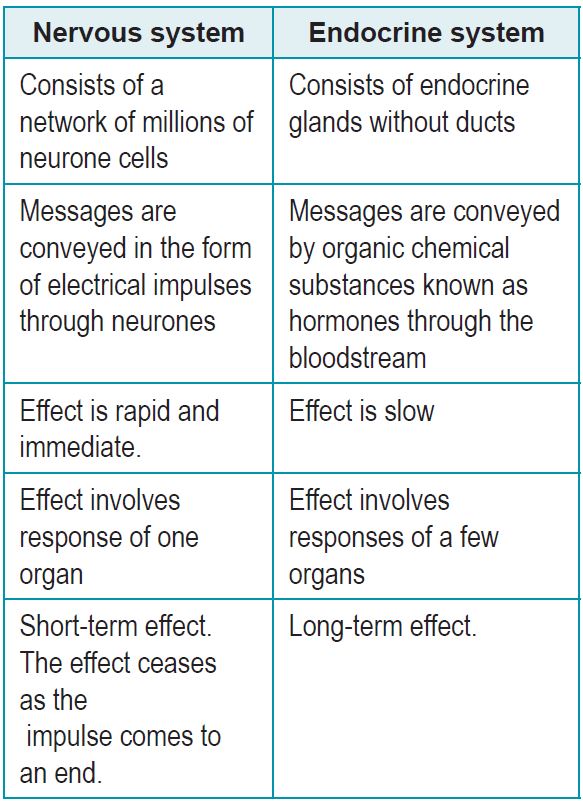Explain the effects of stimulant drugs and sedative drugs on the transmission of impulse through the synapse.
Answer:
• Stimulants such as cocaine prevent the removal of the neurotransmitters that stimulate excitement.
• This will produce an intense euphoric feeling followed by depression.
• Stimulants also increase impulse transmissions that cause increases in the heartbeat and respiration rates.
• Depressants such as heroine will retard and slow down the activities of the nervous system.
• This slows down the production of neurotransmitters which will then reduce the rate of heartbeat and respiration.
• The individual will experience temporary excitement and satisfaction.
(a) (i) Compare and contrast the nervous system and the endocrine system.
(ii) Nora accidentally stepped on a nail. She screamed while holding on to her injured foot. Describe Nora’s reaction when she stepped on the nail.
(b) After tea time, Azman went to the playground to ride his bicycle. While riding his bicycle, Azman is conscious of his action. However, he is not conscious of what is happening to the food that he had just eaten. Describe why Azman is conscious of his action riding the bicycle but is not conscious of the food he had just eaten.
Answer:
(a) (i)
The nervous system and endocrine system have a number of similarities:
• Both have specific target organs.
• Both respond to certain stimuli.
• Both function to coordinate all body activities.
The nervous system and endocrine system also have some differences:

(a) (ii)
• A sharp nail that pierces through the skin causes the sensory receptor in the skin to generate nerve impulses.
• The nerve impulses are transmitted along the sensory neurone to the spinal cord.
• In the spinal cord, the nerve impulses are conveyed from the sensory neurone to the relay neurone.
• From the relay neurone, the nerve impulses are transmitted to the motor neurone.
• The motor neurone carries the nerve impulse from the spinal cord to the effector (muscle tissues) so the foot can be moved immediately.
(b)
• Azman is aware of his action when riding a bicycle because his action involves a voluntary response under his conscious control.
• He is not aware of the food digestion in the digestive tract because digestion is an involuntary response which is beyond his conscious control.
• The control centre involved in riding the bicycle is the central nervous system and involves the musculoskeletal system.
• Azman has past experiences on how to ride a bicycle. This information is triggered in the motor area of the cerebral cortex.
• Since the information is triggered in the cerebral cortex, it is a conscious response.
• The information is then transmitted to the effectors, that is, the skeletal muscles on the foot and arm through the motor neurone.
• The contraction of the skeletal muscles enables Azman to ride the bicycle at his own will. Besides cerebral cortex, information on the body balance is also sent from the balance receptor in the ears to the control centre.
• The control centre involved in food digestion is the medulla oblongata and the muscles involved are the smooth muscles.
• The presence of food in the digestive tract triggers impulses on the receptor and information is sent to the medulla oblongata.
• This information is conveyed to the smooth muscles through the motor neurone. The smooth muscles contract and relax in rhythm to produce a wave of peristalsis that will move the food along the digestive tract.
• Since the information does not reach the cerebral cortex which is responsible for voluntary responses, the perception of food peristalsis does not arise.